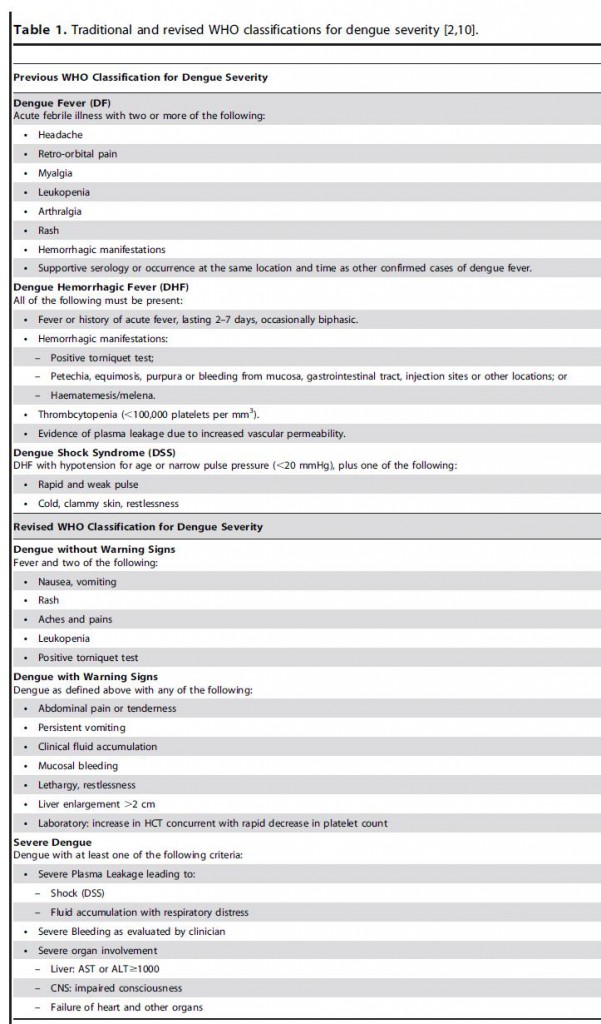Always a risk in some developing countries – but never had a clear picture of the features like this. More for my reference…
PLoS Negl Trop Dis. 2011 Nov;5(11):e1397. Epub 2011 Nov 8.
Evaluation of the Traditional and Revised WHO Classifications of Dengue Disease Severity.
Narvaez F, Gutierrez G, Pérez MA, Elizondo D, Nuñez A, Balmaseda A, Harris E. free article here
better review here
WHO old and new scales:
- Fever, often with sudden onset;
- Severe headache, often retro-ocular;
- Myalgias and arthralgias- can be very severe;
- Abdominal pain:
- abdominal tenderness
- continuous abdominal pain (not intermitent),
- on some occasions diffuse.
- Persistent vomiting: – more than three episodes of vomiting in 12 hours, preventing adequate oral hydration.
- Rashes – maculopapular, petechial, or erythematous
Fluid Accumulation:
-
pleural effusion
-
ascites
-
galllbladder wall thickening,
Mucosal bleeding:
-
bleeding gums or conjunctiva,
-
epistaxis,
-
vaginal bleeding,
-
bleeding from digestive,
-
respiratory bleeding
-
urinary system (kidneys); .
Irritability: irritability or restlessness.
Hepatomegaly: the liver edge more than 2 cm below the costal margin.
Increased hematocrit concurrent with rapid decrease in platelet count: increase in hematocrit together with a decrease of .10,000 platelets/mm3
in 24 hours with respect to previous measurement or concurrent with platelet count #100,000 cells/mm
Tourniquet test – apply BP cuff between diastolic ands systolic for 5 min – positive if over 10 petechia per sq inch – definitely positive if more than 20 / sq in.
Lab:
Traditional scheme seemed more accurate for early Dengue…
Comment – wrote this more as a reminder to me – any comments would ber appreciated…
-
Dengue viral RNA was detected by RT-PCR,
-
Dengue virus (DENV) was isolated,
-
Seroconversion of DENV-specific IgM was detected by MACELISA in paired acute and convalescent samples,
-
DENVspecific antibody titer by Inhibition ELISA demonstrated a 4-fold or greater increase between acute and convalescent sera.
Saudi Med J. 2017 Oct;38(10):1025-1033. doi: 10.15537/smj.2017.10.20965.
Dengue fever. Clinical features of 567 consecutive patients admitted to a tertiary care center in Saudi Arabia.
Badreddine S1, Al-Dhaheri F, Al-Dabbagh A, Al-Amoudi A, Al-Ammari M, Elatassi N, Abbas H, Magliah R, Malibari A, Almoallim H.
Author information
Abstract
OBJECTIVES:
To delineate the clinical features and outcomes of dengue infection and to guide clinician of early diagnosis and identification of risks factors for dengue hemorrhagic fever. Methods: This study is a retrospective cross-sectional. Clinical records of 567 patients with a confirmed diagnosis of dengue infection, admitted to a single hospital in Jeddah, Saudi Arabia, between January 2010 and June 2014 were reviewed. Results: Dengue infection was most common in adult males. Sixty-eight percent of infections were in Saudi nationals. In addition to the diagnostic clinical features, leucopenia and thrombocytopenia were typical of dengue infection. Approximately 4.1% of adult patients and 7.1% of pediatric patients developed dengue hemorrhagic fever (DHF). Abdominal pain and vomiting were more common in patients developing DHF. Mean platelet count was lower in adult, but not pediatric patients developing DHF. Peak alanine aminotransferase (ALT) was higher in adult and pediatric patients developing DHF. Three patients died, 2 of them developed DHF. Ninety-eight percent of adult patients and 92% of pediatric patients made a full recovery. Conclusions: Dengue infection is common in Jeddah. Abdominal pain and vomiting, thrombocytopenia, and elevated ALT are typical of severe infection, which is more likely to be associated with significant morbidity and mortality.

